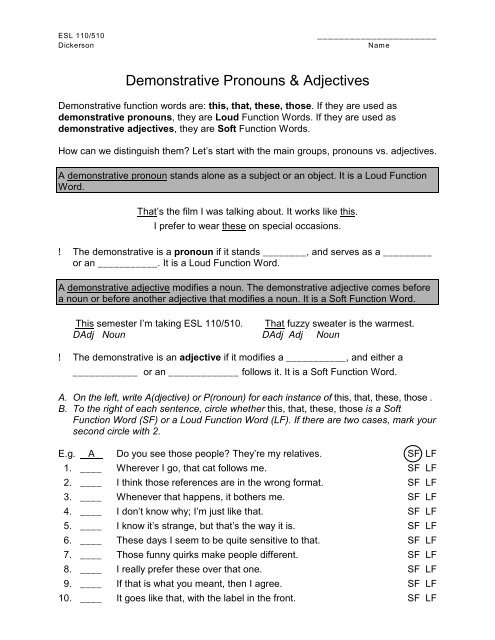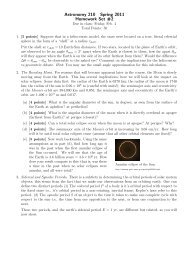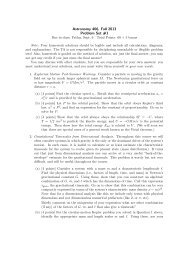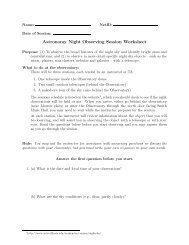Demonstrative Pronouns & Adjectives
Demonstrative Pronouns & Adjectives
Demonstrative Pronouns & Adjectives
- No tags were found...
Create successful ePaper yourself
Turn your PDF publications into a flip-book with our unique Google optimized e-Paper software.
ESL 110/510<br />
Dickerson<br />
______________________<br />
Name<br />
<strong>Demonstrative</strong> <strong>Pronouns</strong> & <strong>Adjectives</strong><br />
<strong>Demonstrative</strong> function words are: this, that, these, those. If they are used as<br />
demonstrative pronouns, they are Loud Function Words. If they are used as<br />
demonstrative adjectives, they are Soft Function Words.<br />
How can we distinguish them? Let’s start with the main groups, pronouns vs. adjectives.<br />
A demonstrative pronoun stands alone as a subject or an object. It is a Loud Function<br />
Word.<br />
That’s the film I was talking about. It works like this.<br />
I prefer to wear these on special occasions.<br />
! The demonstrative is a pronoun if it stands ________, and serves as a _________<br />
or an ___________. It is a Loud Function Word.<br />
A demonstrative adjective modifies a noun. The demonstrative adjective comes before<br />
a noun or before another adjective that modifies a noun. It is a Soft Function Word.<br />
This semester I’m taking ESL 110/510. That fuzzy sweater is the warmest.<br />
DAdj Noun DAdj Adj Noun<br />
! The demonstrative is an adjective if it modifies a ___________, and either a<br />
____________ or an _____________ follows it. It is a Soft Function Word.<br />
A. On the left, write A(djective) or P(ronoun) for each instance of this, that, these, those .<br />
B. To the right of each sentence, circle whether this, that, these, those is a Soft<br />
Function Word (SF) or a Loud Function Word (LF). If there are two cases, mark your<br />
second circle with 2.<br />
E.g. A Do you see those people? They’re my relatives. SF LF<br />
1. ____ Wherever I go, that cat follows me. SF LF<br />
2. ____ I think those references are in the wrong format. SF LF<br />
3. ____ Whenever that happens, it bothers me. SF LF<br />
4. ____ I don’t know why; I’m just like that. SF LF<br />
5. ____ I know it’s strange, but that’s the way it is. SF LF<br />
6. ____ These days I seem to be quite sensitive to that. SF LF<br />
7. ____ Those funny quirks make people different. SF LF<br />
8. ____ I really prefer these over that one. SF LF<br />
9. ____ If that is what you meant, then I agree. SF LF<br />
10. ____ It goes like that, with the label in the front. SF LF
The following description applies only to the word ‘that’. In this usage, ‘that’ is not a<br />
demonstrative, neither a demonstrative adjective nor a demonstrative pronoun. We<br />
mention this case because it can be confused with demonstratives.<br />
In a common usage, ‘that’ is a relative pronoun found in three cases: (1) ‘That’<br />
introduces an embedded sentence. (2) ‘That’ follows a noun and is the subject of an<br />
embedded sentence which describes the noun. (3) ‘That’ follows a noun and<br />
introduces an embedded sentence which describes the noun. In all three cases, ‘that’<br />
is a Soft Function Word and is pronounced as /ðt/.<br />
I forgot that he was coming over.<br />
EMBEDDED SENTENCE<br />
Here’s the package that was lost.<br />
NOUN EMBEDDED SENTENCE<br />
The message that he sent was rude.<br />
NOUN<br />
EMBEDDED SENTENCE<br />
In the first example above, ‘that’ comes right before the embedded sentence, he was<br />
coming over.<br />
In the second example above, ‘that’ comes after the noun package and is the subject of<br />
the embedded sentence that was lost which describes package.<br />
In the third example above, ‘that’ comes after the noun message and introduces an<br />
embedded sentence, he sent, that describes message.<br />
Compare the first two sentences below, which have demonstratives, with the sentences<br />
that follow, which have relative pronouns:<br />
If that freezes, it will crack. ‘that’ = dem pronoun<br />
‘that’ does not modify a preceding noun; it stands alone; it is the subject<br />
I know that teacher well. ‘that’ = dem adjective<br />
‘that’ is not the subject of a sentence; it does not introduce a sentence<br />
I know that (he’s doing his best). ‘that’ = relative, introducing sentence (..)<br />
I want to be sure that (she got home safely). ‘that’ = relative, introducing sentence (..)<br />
He’s the teacher that (I like best). ‘that’ = relative, introducing sentence (..)<br />
The team (that won) was ours. ‘that’ = relative; ‘that’ is subject of (..) modifying ‘team’<br />
We knew the child (that was hurt). ‘that’ = relative; ‘that’ is subject of (..) modifying ‘child’<br />
The quote that (he found) was good. ‘that’ = relative, introducing (..) which describes ‘quote’<br />
! ‘That’ is a relative pronoun if it introduces an ___________ ___________, or is the<br />
___________ of an embedded sentence, modifying the preceding ___________, or<br />
introduces an ___________ ___________ that describes the preceding _________.
A. On the left, write A(djective), P(ronoun) or RP for relative pronoun. If there is more<br />
than one instance of this, that, these, those, write A, P or RP for each.<br />
B. To the right of each sentence, circle whether this, that, these, those is a Soft<br />
Function Word (SF) or a Loud Function word (LF). If there are two cases, mark<br />
your second circle with 2.<br />
E.g. RP He suggested that I circulate a memo first. SF LF<br />
1. ____ Those dark leaves turn bright red in the fall. SF LF<br />
2. ____ Corn that germinates early is sweeter. SF LF<br />
3. ____ The exam that we took was supposed to be tough. SF LF<br />
4. ____ Imagine that! A candle that burns twice as long! SF LF<br />
5. ____ He should apologize because that was wrong. SF LF<br />
6. ____ I’d like these old exams filed in that cabinet. SF LF<br />
7. ____ I saw an article that described it pretty well. SF LF<br />
8. ____ Since these won’t work, let’s try something else. SF LF<br />
9. ____ Please give me your opinion of this memo by tomorrow? SF LF<br />
10. ____ Every time I think of that, I get sick. SF LF<br />
11. ____ Try to avoid people that act like that. SF LF<br />
12. ____ I know that we’re all a bit strange. SF LF<br />
13. ____ He thought that George would stay at home. SF LF<br />
14. ____ Hand me those needle-nose pliers, would you? SF LF<br />
15. ____ Free tickets! What do you think of that? SF LF<br />
16. ____ The picture that we liked best is gone. SF LF<br />
17. ____ That was never one of his faults! SF LF<br />
18. ____ Those were the days, weren’t they! SF LF<br />
19. ____ You should try this new diet. It really works! SF LF<br />
20. ____ We knew that it was unfair, but we did it anyway. SF LF<br />
Summary: Whenever this, that, these, or those stands alone as a subject or an object, it<br />
is a demonstrative pronoun, a Loud Function Word, and is pronounced with a full<br />
vowel: /ðs/, /ðæt/, /ðiyz/, /ðowz/. All other uses of these words are Soft Function Words.<br />
Answers: p. 1. 1. A, SF; 2. A, SF; 3. P, LF. p. 3. 1. A, SF; 2. RP, SF; 3. RP, SF.






